Nationwide WWSCAN July 2024 Update
Hi everyone,
This newsletter contains updates on the WastewaterSCAN program with wastewater samples analyzed by the lab through July 31, 2024. Below you will find information on the program in terms of participating partners, review of targets being measured, as well as current categories (low, medium, high) of the infectious disease targets.
Ali & Marlene
Participating Plants
147 WWTPs plants sampling across 40 states
WastewaterSCAN Participant Stats:
- 147 plants sampling
- >37 million people covered through sampling efforts
- 40 states
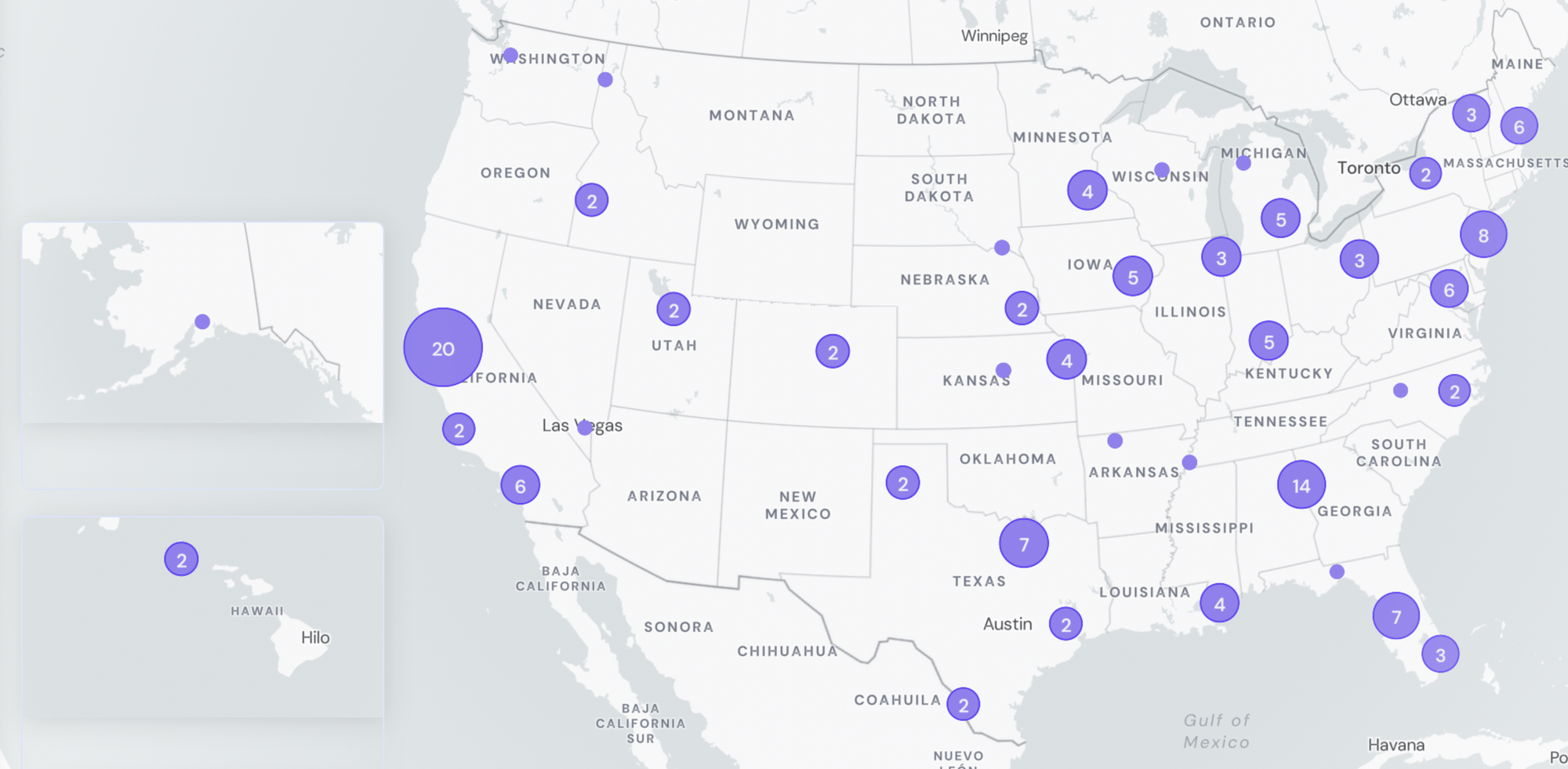
Infectious Disease Target Review
Currently monitoring a suite of Respiratory, Gastrointestinal and Outbreak Pathogens of Concern
The methods for our assays are in the public domain and links for these are provided at the end of the newsletter.
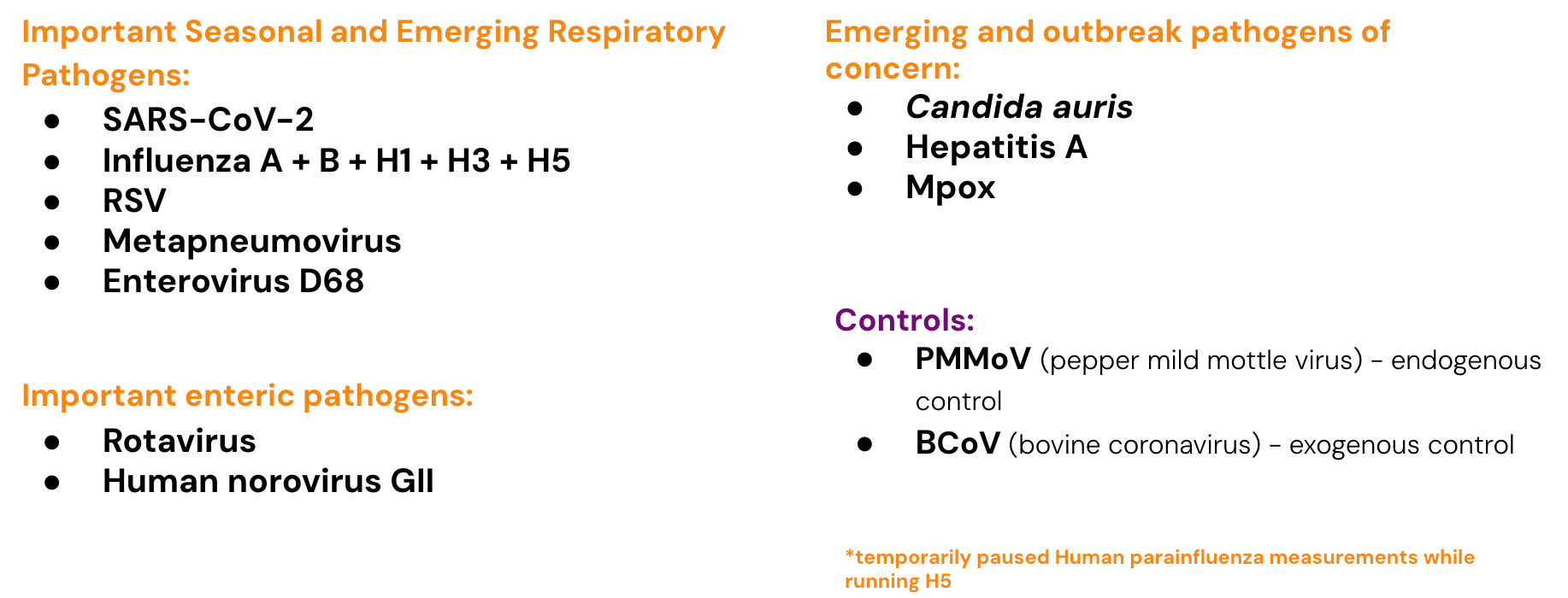
Program Publications
New WastewaterSCAN Published Body of Work document:
- We are excited to share a new document that provides an overview of the program’s peer-reviewed scientific literature, organized by topics and themes. Click here to access the WastewaterSCAN published body of work.
New Peer-Reviewed Scientific Publications:
- Prospective study of Candida auris nucleic acids in wastewater solids in 190 wastewater treatment plants in the United States suggests widespread occurrence
- Spatial and temporal variation in respiratory syncytial virus (RSV) subtype RNA in wastewater and relation to clinical specimens
- Detection of Hemagglutinin H5 Influenza A Virus Sequence in Municipal Wastewater Solids at Wastewater Treatment Plants with Increases in Influenza A in Spring, 2024
COVID-19
SARS-CoV-2 concentration in wastewater and sequencing for variants
SARS-CoV-2 N gene RNA median concentration across all sites in July 2024 was 93,745 copies/gram. For reference, the median concentration in July 2023 was 41,239 copies/gram. Below is the population weighted average SARS-CoV-2 N gene concentrations (normalized by PMMoV) from all participating WWSCAN sites across the country over the last 365 days.
Nationally, SARS-CoV-2 is in the "High" category with aggregated measurements showing high concentrations and an upward over the past 21 days.

Below are the population-weighted average SARS-CoV-2 N gene concentrations (normalized by PMMoV) from sites in the Midwest US (top left panel), Northeast US (top right panel), Southern US (bottom left panel) and Western US (bottom right panel) over the last 365 days. Raw data have been omitted from the plots for clarity of presentation but are still available in the chart settings on dashboard.
All regions are in the "High" Wastewater Category due to high concentrations, with the Midwest and South showing an upward trend in the last 21 days and the Northeast and West showing no significant trend over the last 21 days.
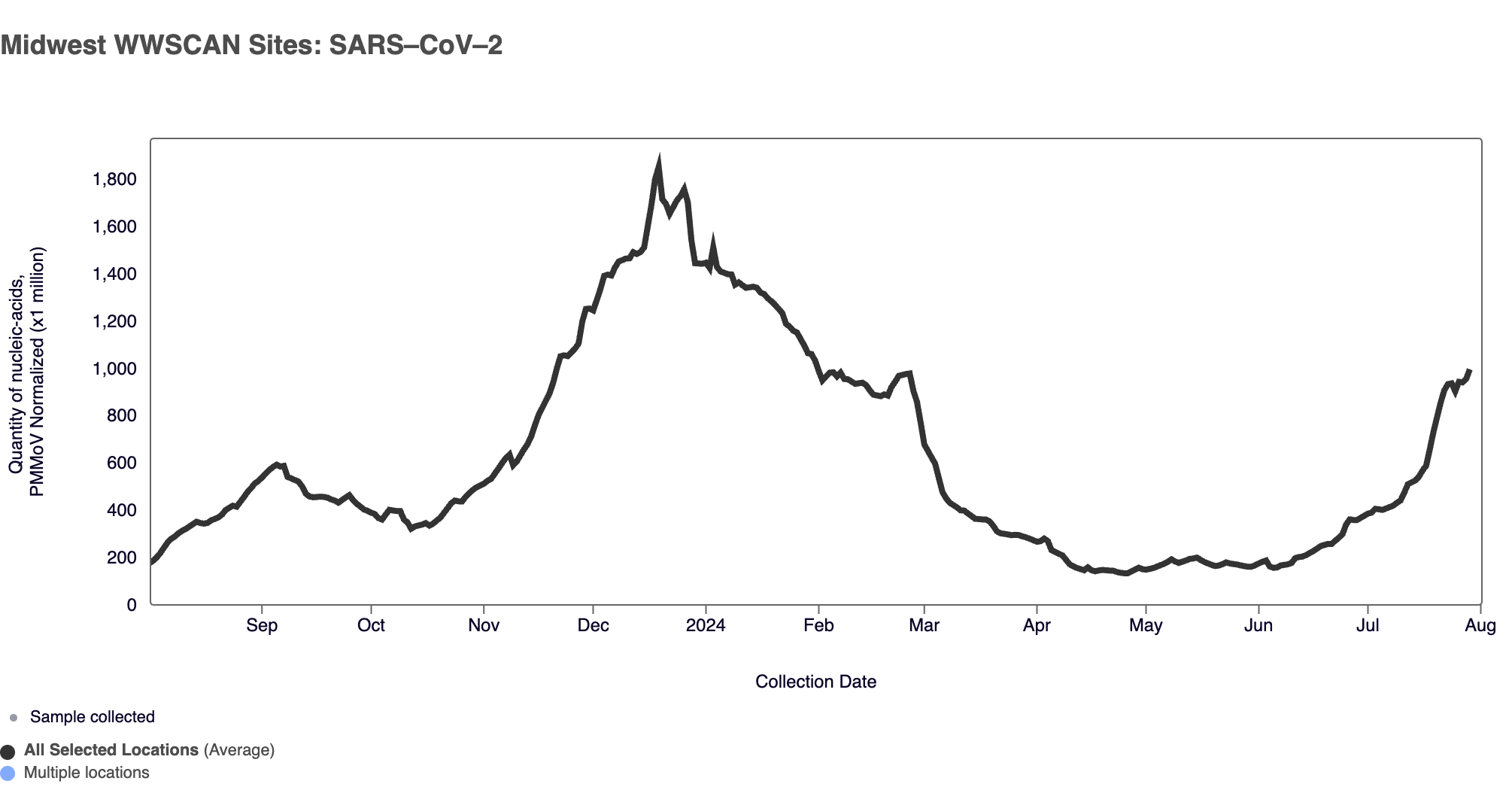
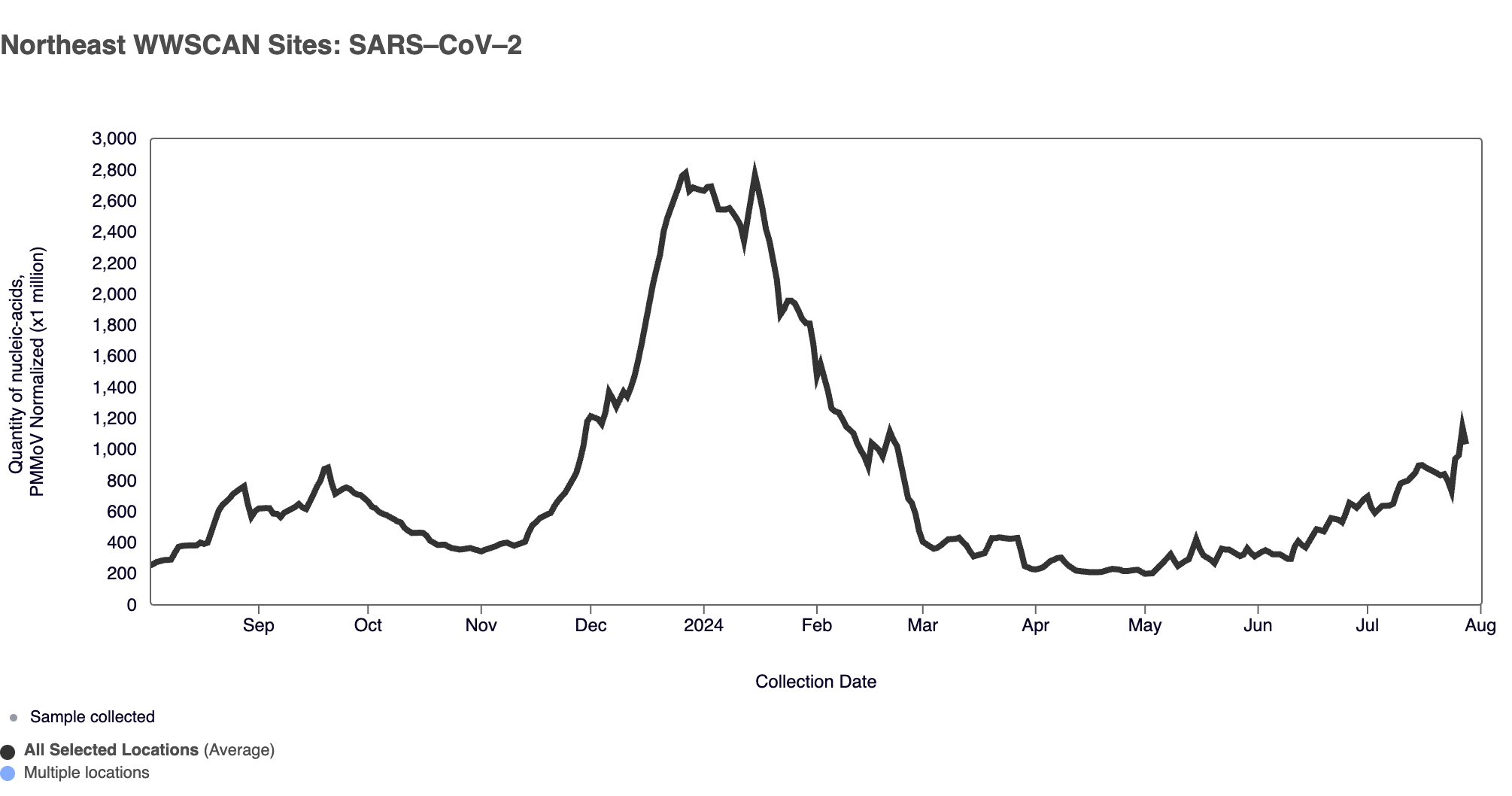
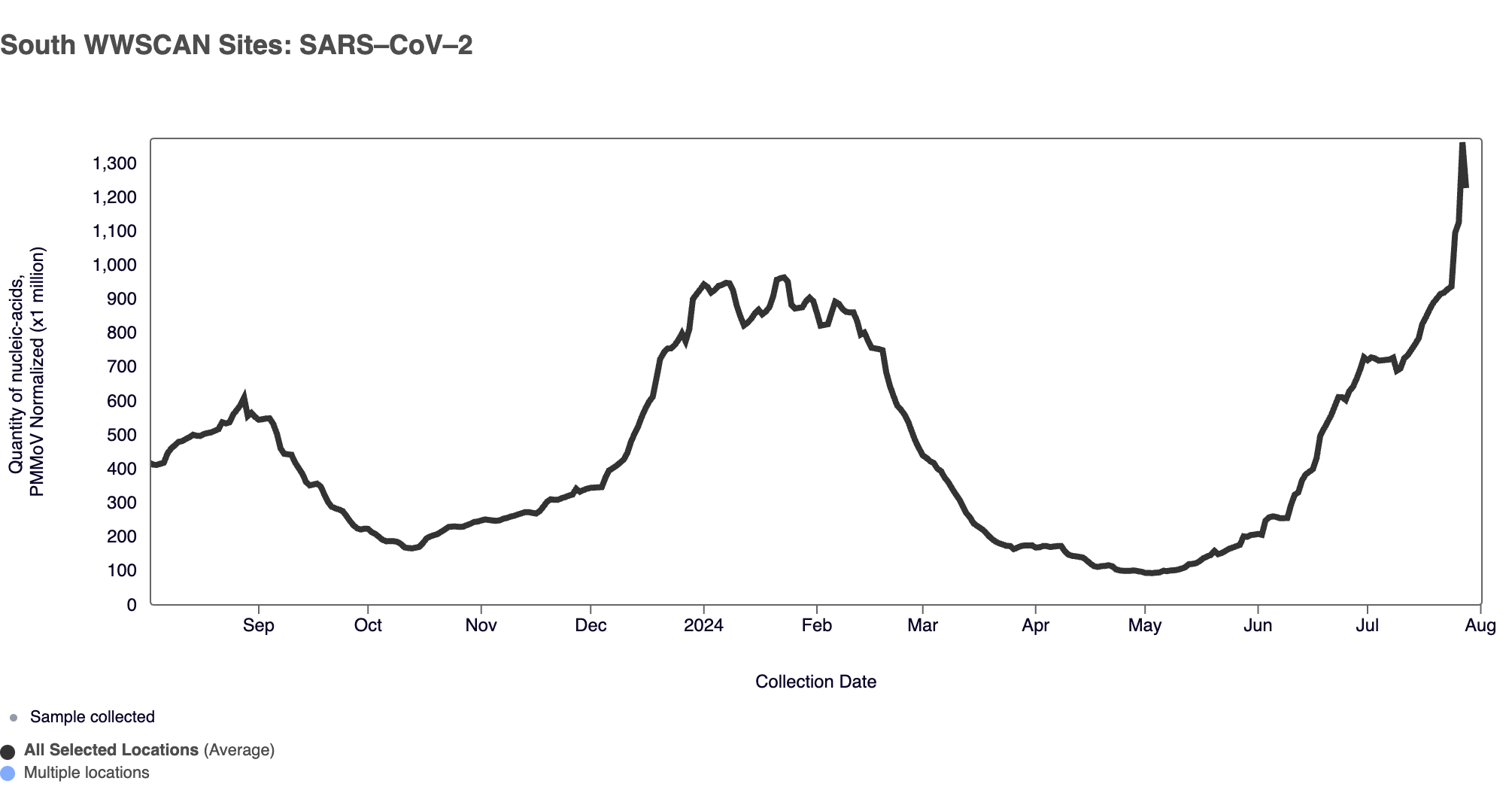
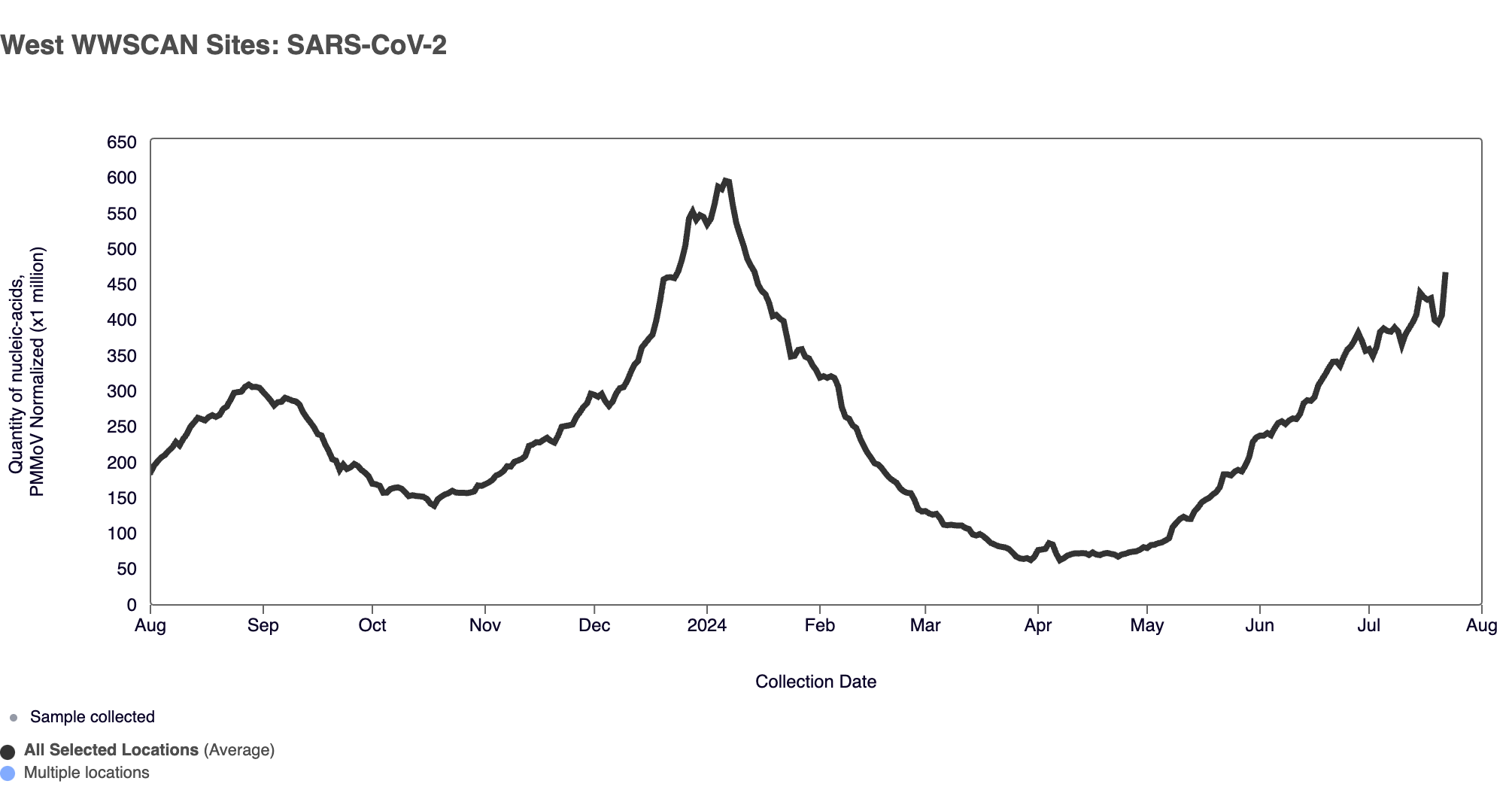
Midwest states: IA, IL, IN, KS, MI, MN, NE, OH, SD, WI. Northeast states: CT, MA, ME, NH, NJ, NY, PA, VT. Southern states: AL, AR, DE, FL, GA, KY, LA, MD, MS, NC, TN, TX, VA, WV and Washington DC. Western States: AK, CA, CO, HI, ID, NV, UT, WA.
Below are the current SARS-CoV-2 wastewater categories for all WWSCAN sites (recall the category is determined by both the trend and the level):
- 7 are in the LOW Wastewater Category
- 30 are in the MEDIUM Wastewater Category
- 100 are in the HIGH Wastewater Category
- 11 do not have enough data to calculate
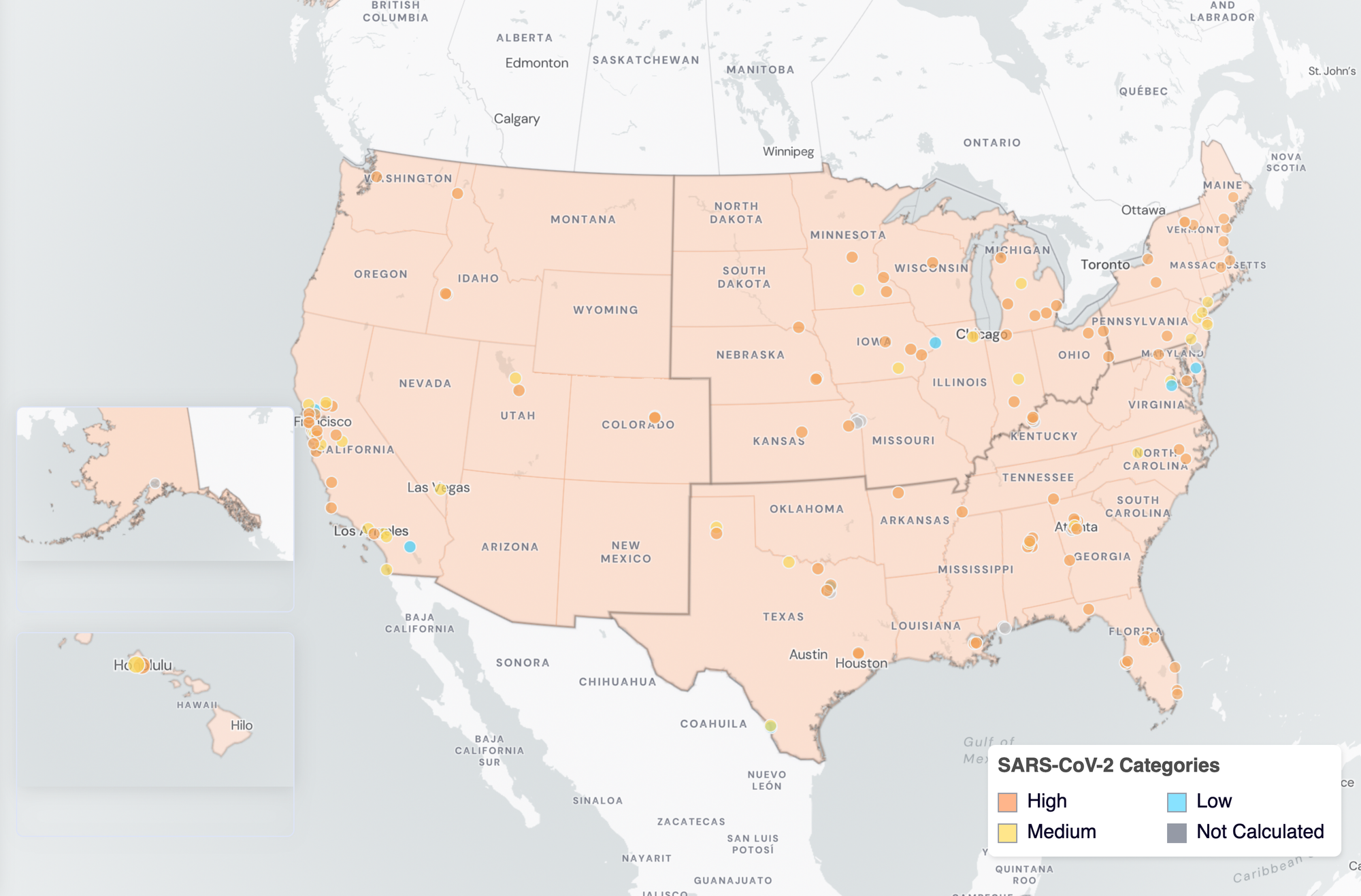
SARS-COV-2 Wastewater Categories. This map includes sample collection data through July 31, 2024. Each dot represents a single site and the four US Census regions are outlined in gray. Midwest Region includes: IA, IL, IN, KS, MI, MN, NE, OH, SD, WI. Northeast Region includes: CT, MA, ME, NH, NJ, NY, PA, VT. Southern Region includes: AL, AR, DE, FL, GA, KY, LA, MD, MS, NC, TN, TX, VA, WV and Washington DC. Western Region includes: AK, CA, CO, HI, ID, NV, UT, WA.
Sequencing of SARS-CoV-2 from wastewater is available for a select number of individual sites. The sequencing protocol is available on protocol.io. The plots below show the relative proportions of different variants inferred from sequencing the entire genome of SARS-CoV-2. Results are based on sequencing of 2 samples per week, combined to provide a weekly value.
Sequencing data is also available in aggregate across all sites in WWSCAN with sequencing data. That plot is shown below and also suggests that KP.2 (shown in slate blue) is the most abundant variant across all sites (43.1%) followed by KP.3 (shown in light blue) (19.4%) and JN.1.1.16 (shown in pink) (13.3%).

Data from the week of July 20, 2024 illustrates that KP.2 (slate blue) made up the largest proportion of the lineages detected at detected at Bessemer, AL (37.4%).Whereas KP.3 (light blue) made up the largest proportion of the lineages detected at detected at Anchorage, AK (76.6%), Chester, PA (43.6%), and Glen Ellyn, IL (42.5%).
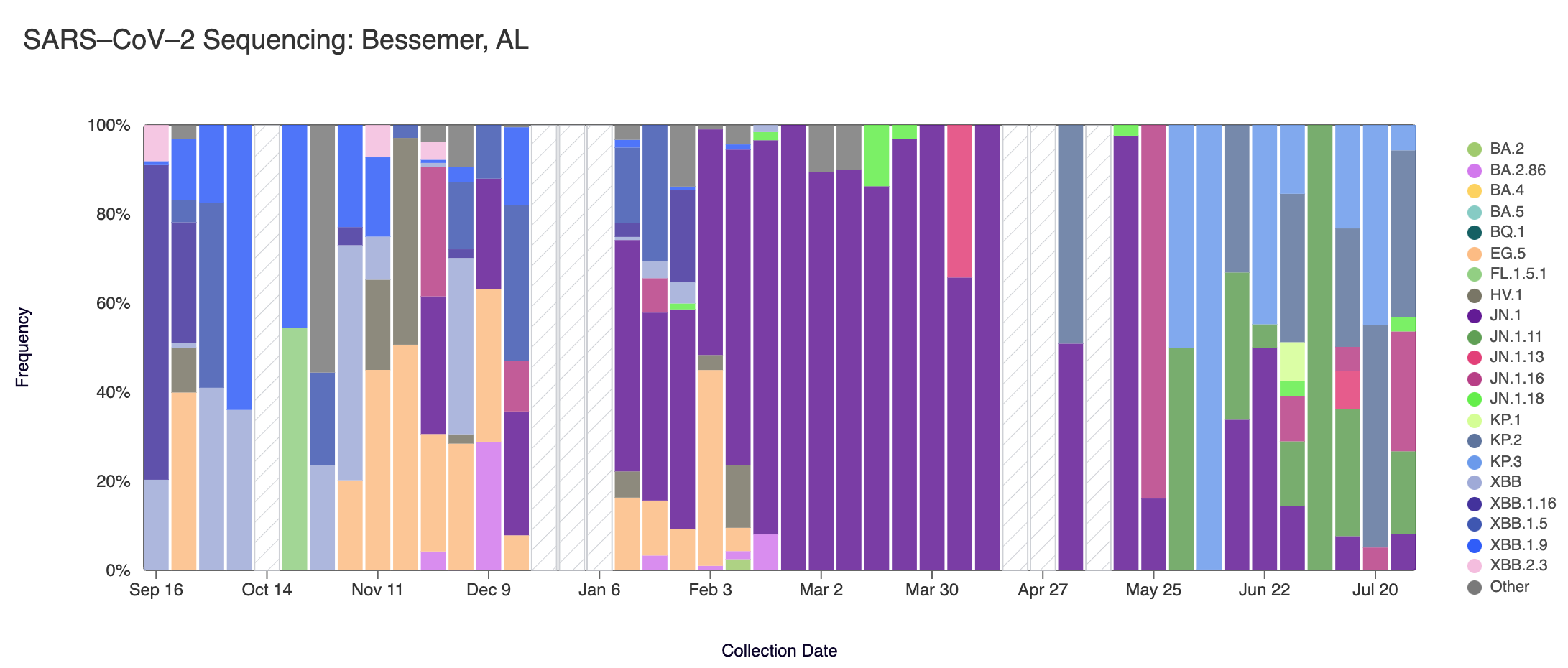
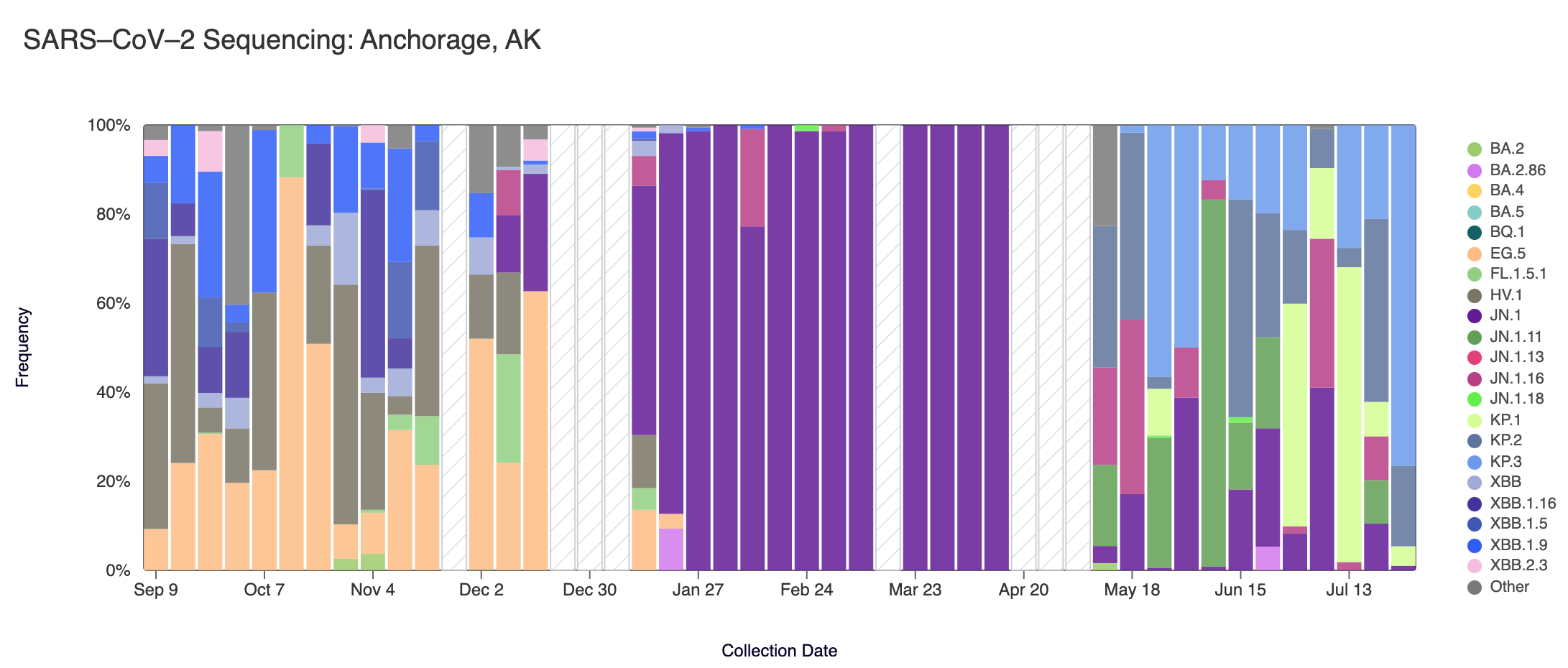
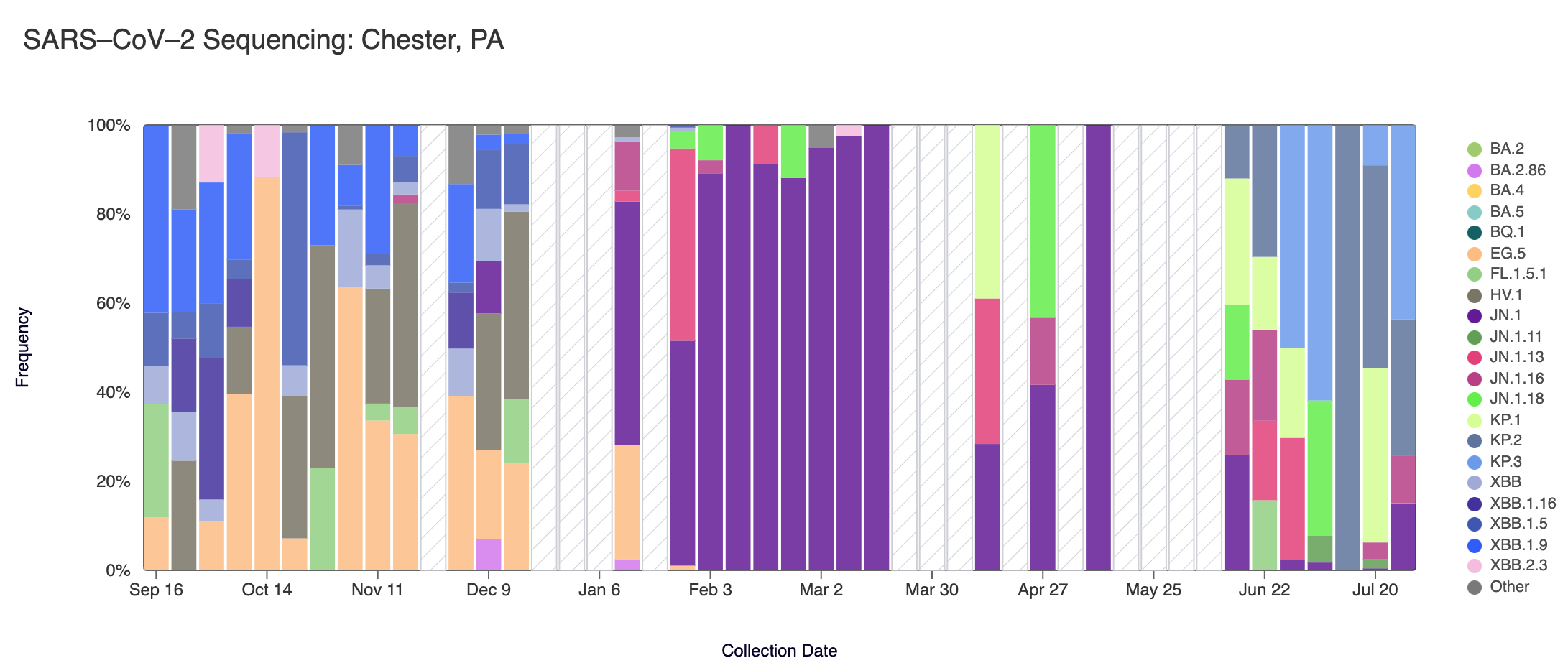
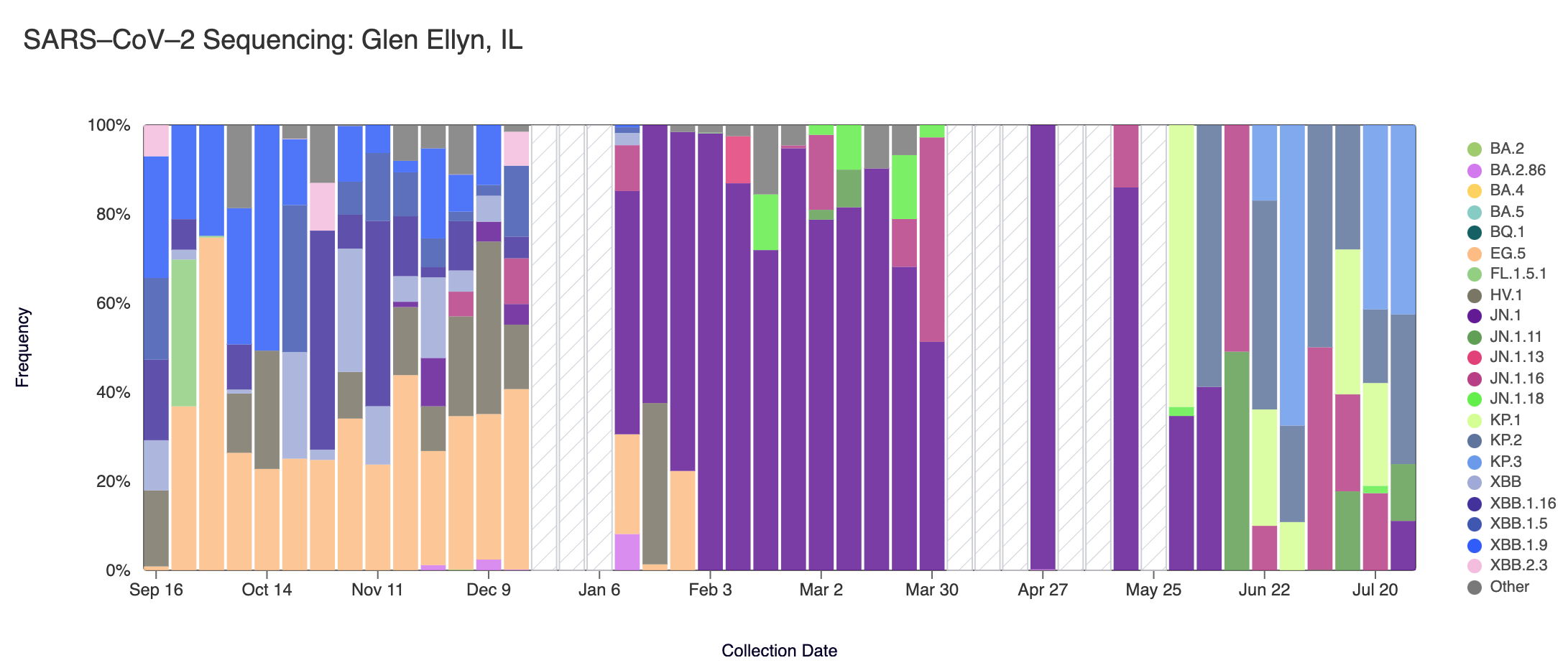
Plots show 1 site from the Southern US (top left panel), Western US (top right panel), Northeast US (bottom left panel) and Midwest US (bottom right panel)
Other Respiratory Pathogens
Influenza A & B, Respiratory Syncytial Virus, Human metapneumovirus, Human Parainfluenza & EV-D68
Influenza A (IAV) RNA median concentration across all sites July 2024 was below the limit of detection. For reference, the median concentration in June 2024 was below the limit of detection as well. Below is the population weighted average IAV concentrations (normalized by PMMoV) from all participating WWSCAN sites across the country over the last 365 days.
Nationally, Influenza A is in the "Low" Wastewater Category with <50% of sites showing onset of IAV in wastewater.

Below are the current Influenza A wastewater categories for all WWSCAN sites (recall the category is determined by both the trend and the level when in seasonal onset):
- 126 are in the LOW Wastewater Category
- 8 are in the MEDIUM Wastewater Category
- 3 are in the HIGH Wastewater Category
- 11 do not have enough data to calculate
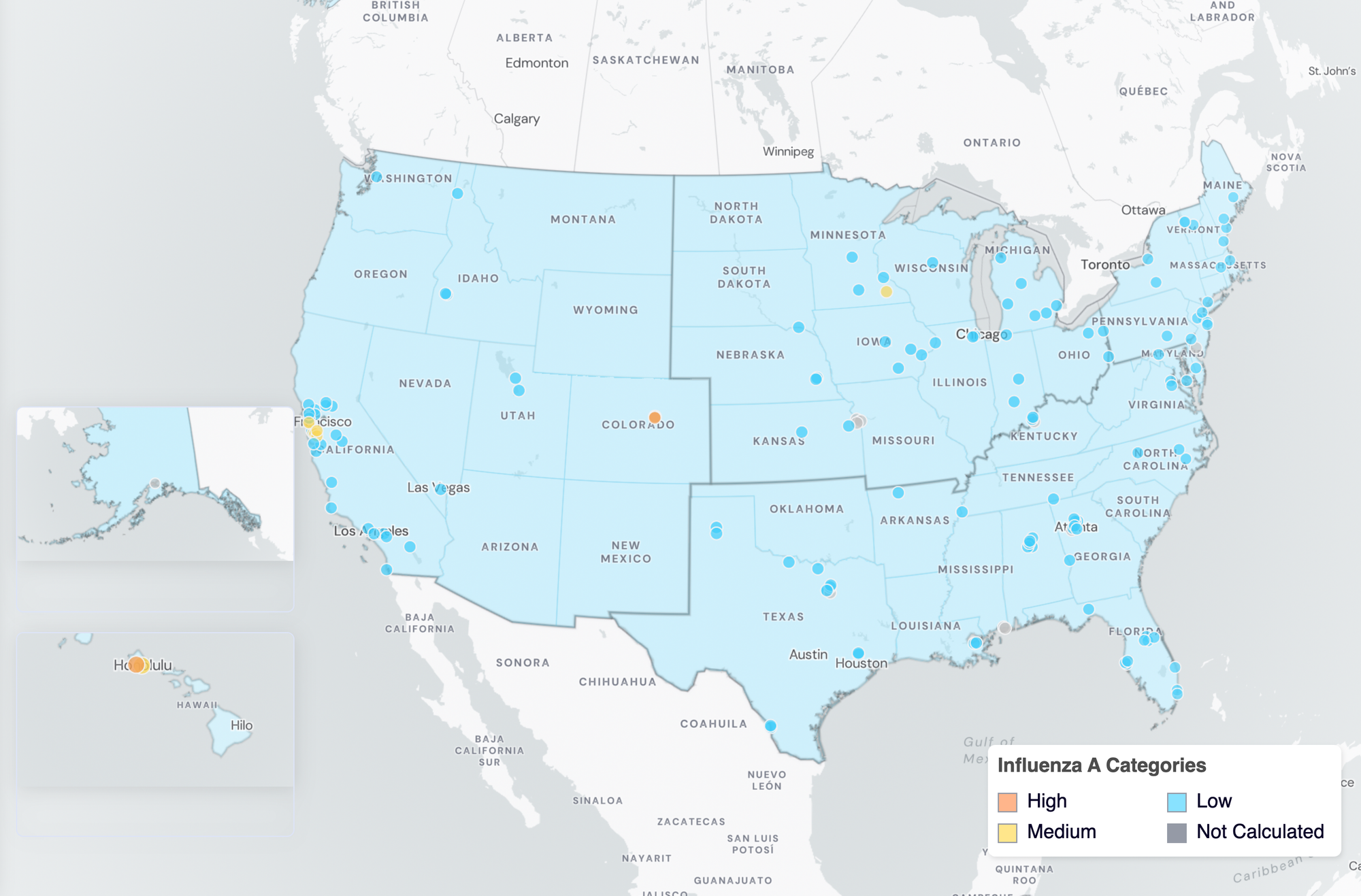
Influenza A Wastewater Categories. This map includes sample collection data through July 31, 2024. Each dot represents a single site and the four US Census regions are outlined in gray. Midwest Region includes: IA, IL, IN, KS, MI, MN, NE, OH, SD, WI. Northeast Region includes: CT, MA, ME, NH, NJ, NY, PA, VT. Southern Region includes: AL, AR, DE, FL, GA, KY, LA, MD, MS, NC, TN, TX, VA, WV and Washington DC. Western Region includes: AK, CA, CO, HI, ID, NV, UT, WA.
H5 Marker in Influenza A (IAV) Since we started monitoring for the H5 marker in influenza A, 26 WastewaterSCAN sites have seen positive detections.
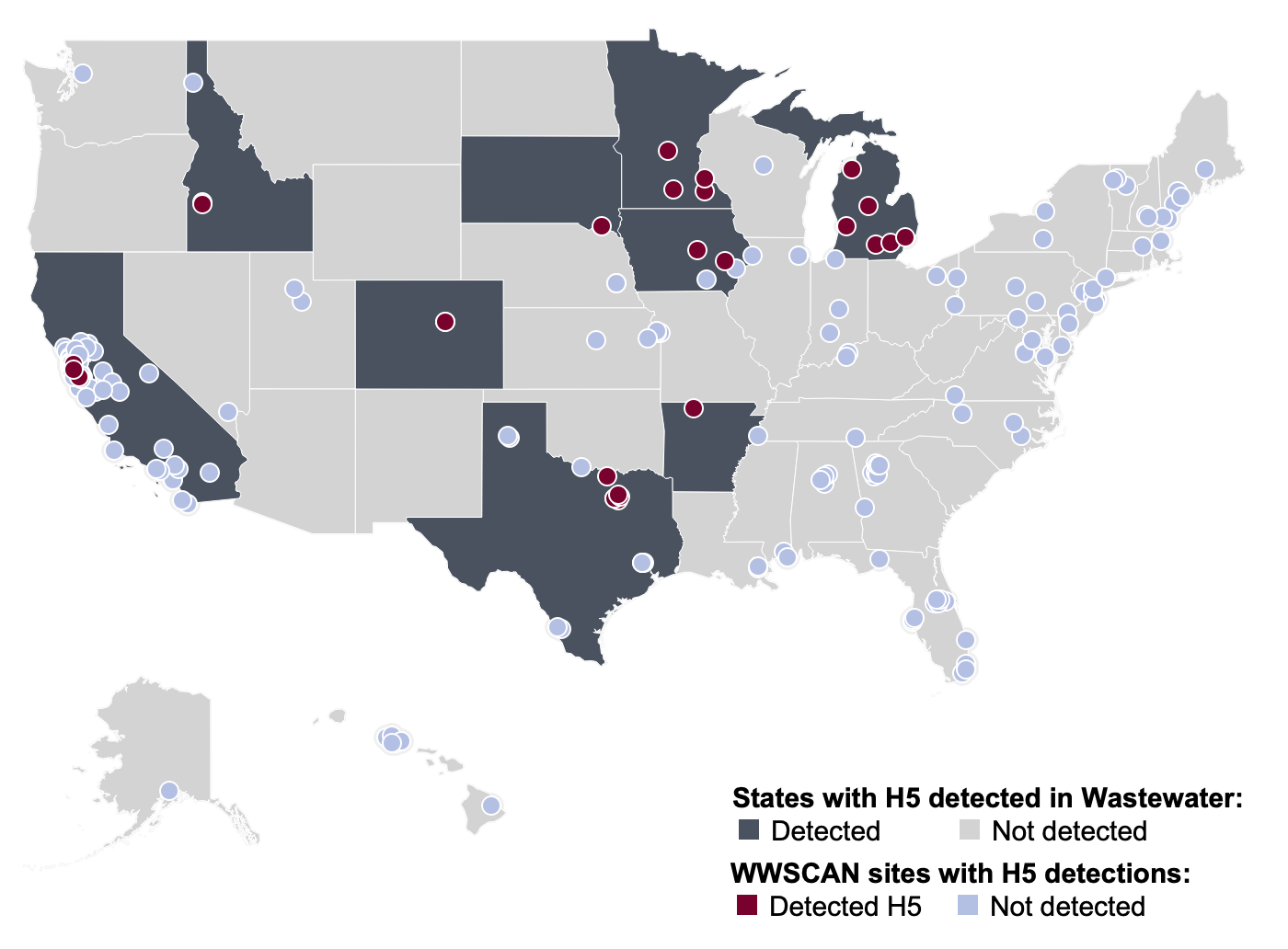
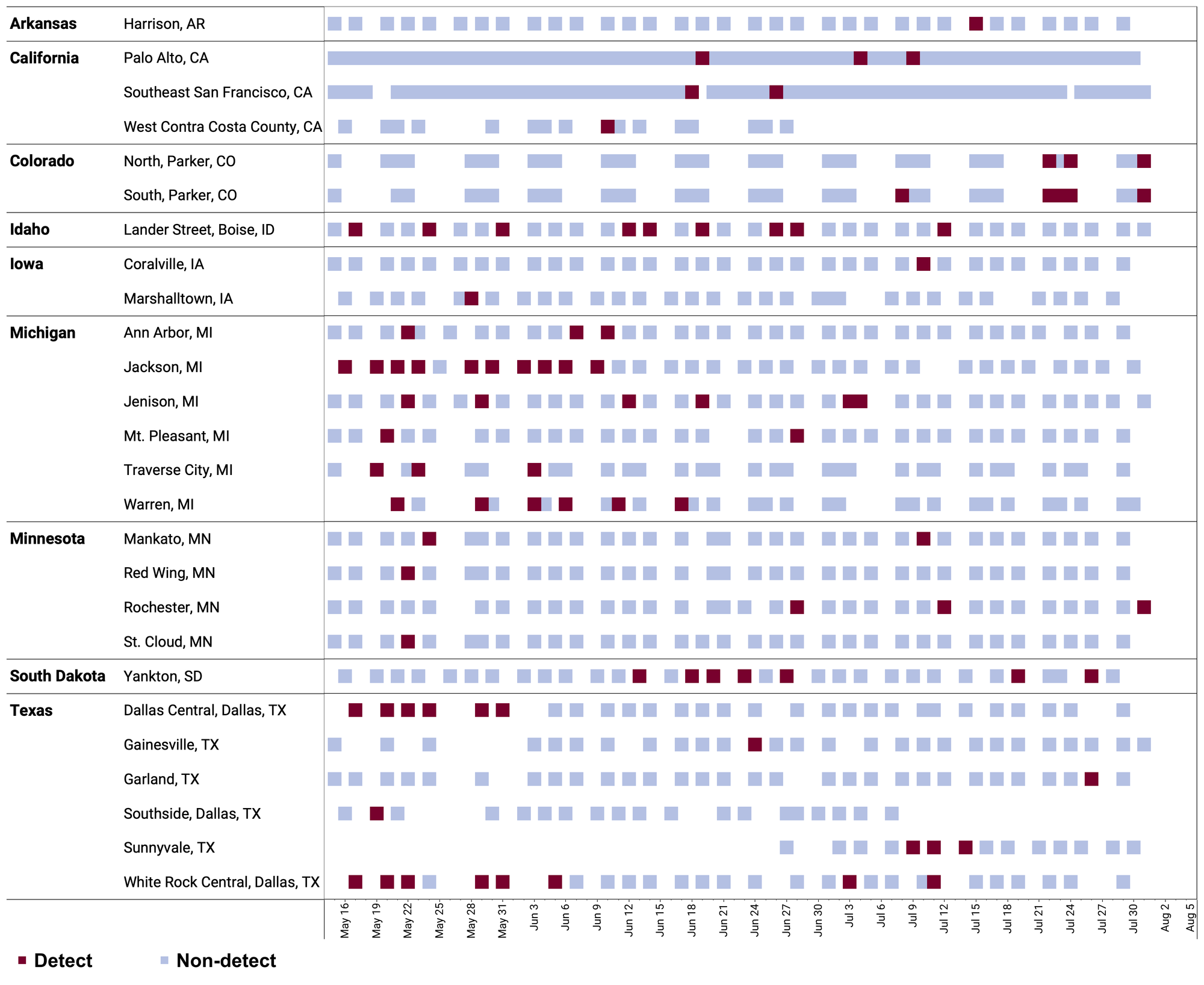
Heat map of the 26 WastewaterSCAN sites that have had positive detection(s) of the H5 marker in Influenza A as of July 31, 2024
Influenza B (IBV) RNA was detected in ~7% of samples in July 2024. IBV RNA median concentration across all sites in July 2024 was below the limit of detection. Below is the population-weighted average IBV RNA concentrations (normalized by PMMoV) from all participating WWSCAN sites across the country over the last 365 days.
Nationally, Influenza B is in the "Low" Wastewater Category with <50% of sites showing onset of IBV in wastewater.

Below are the current Influenza B wastewater categories for all WWSCAN sites (recall the category is determined by both the trend and the level when in seasonal onset):
- 137 are in the LOW Wastewater Category
- 0 are in the MEDIUM Wastewater Category
- 0 are in the HIGH Wastewater Category
- 11 do not have enough data to calculate
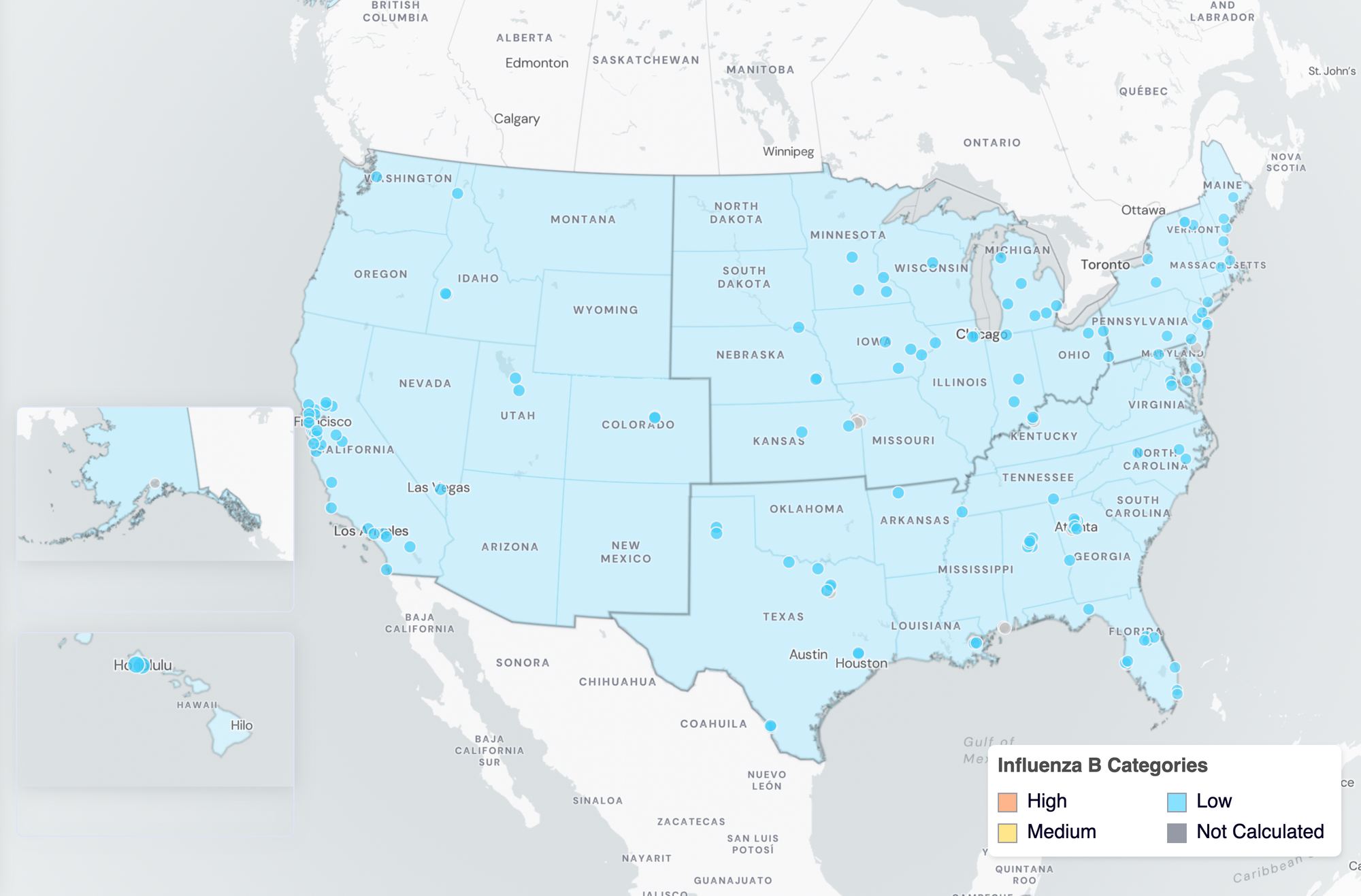
IBV Wastewater Categories. This map includes sample collection data through July 31, 2024. Each dot represents a single site and the four US Census regions are outlined in gray. Midwest Region includes: IA, IL, IN, KS, MI, MN, NE, OH, SD, WI. Northeast Region includes: CT, MA, ME, NH, NJ, NY, PA, VT. Southern Region includes: AL, AR, DE, FL, GA, KY, LA, MD, MS, NC, TN, TX, VA, WV and Washington DC. Western Region includes: AK, CA, CO, HI, ID, NV, UT, WA.
Respiratory syncytial virus (RSV) RSV RNA median concentration across all sites in July 2024 was below the limit of detection. Below are the RSV RNA concentrations (normalized by PMMoV) from all participating WWSCAN sites across the country over the last 365 days shown as the population-weighted average.
Nationally, RSV is in the "Low" Wastewater Category, with <50% of sites showing onset of RSV in wastewater.

Below are the current RSV wastewater categories for all WWSCAN sites (recall the category is determined by both the trend and the level when in seasonal onset):
- 137 are in the LOW Wastewater Category
- 0 are in the MEDIUM Wastewater Category
- 0 are in the HIGH Wastewater Category
- 11 do not have enough data to calculate
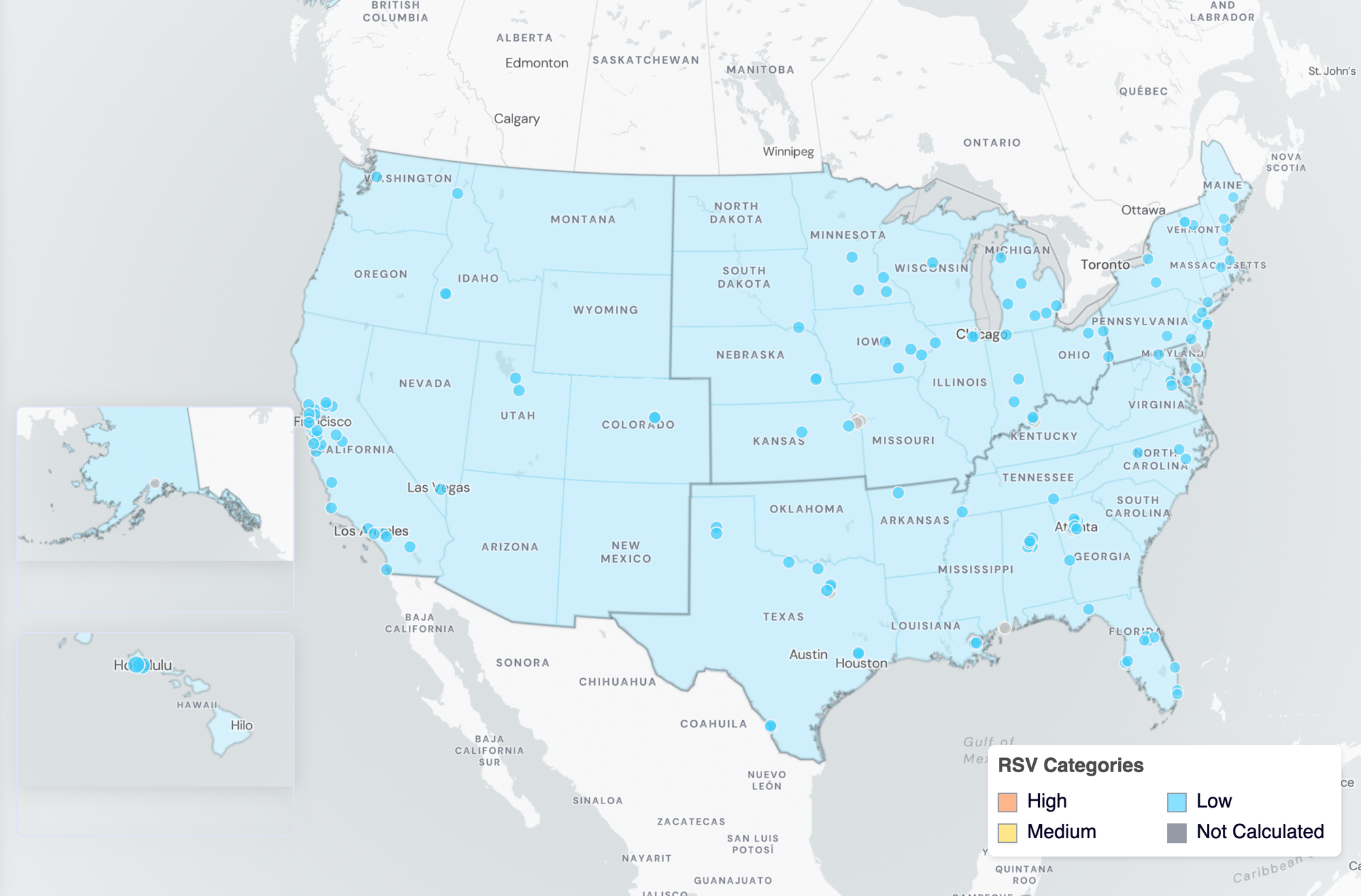
RSV Wastewater Categories. This map includes sample collection data through July 31, 2024. Each dot represents a single site and the four US Census regions are outlined in gray. Midwest Region includes: IA, IL, IN, KS, MI, MN, NE, OH, SD, WI. Northeast Region includes: CT, MA, ME, NH, NJ, NY, PA, VT. Southern Region includes: AL, AR, DE, FL, GA, KY, LA, MD, MS, NC, TN, TX, VA, WV and Washington DC. Western Region includes: AK, CA, CO, HI, ID, NV, UT, WA.
HMPV (human metapneumovirus) RNA median concentrations across all sites in July 2024 was below the level of detection. HMPV RNA was detected in ~22% of samples in July 2024. Below is the population weighted average HMPV RNA concentrations (normalized by PMMoV) from all participating WWSCAN sites across the country over the last 365 days.
Nationally, HMPV is in the "LOW" Wastewater Category with <50% of sites showing onset of HMPV in wastewater.

Below are the current HMPV wastewater categories for all WWSCAN sites (recall the category is determined by both the trend and the level):
- 135 are in the LOW Wastewater Category
- 1 are in the MEDIUM Wastewater Category
- 1 are in the HIGH Wastewater Category
- 11 do not have enough data to calculate
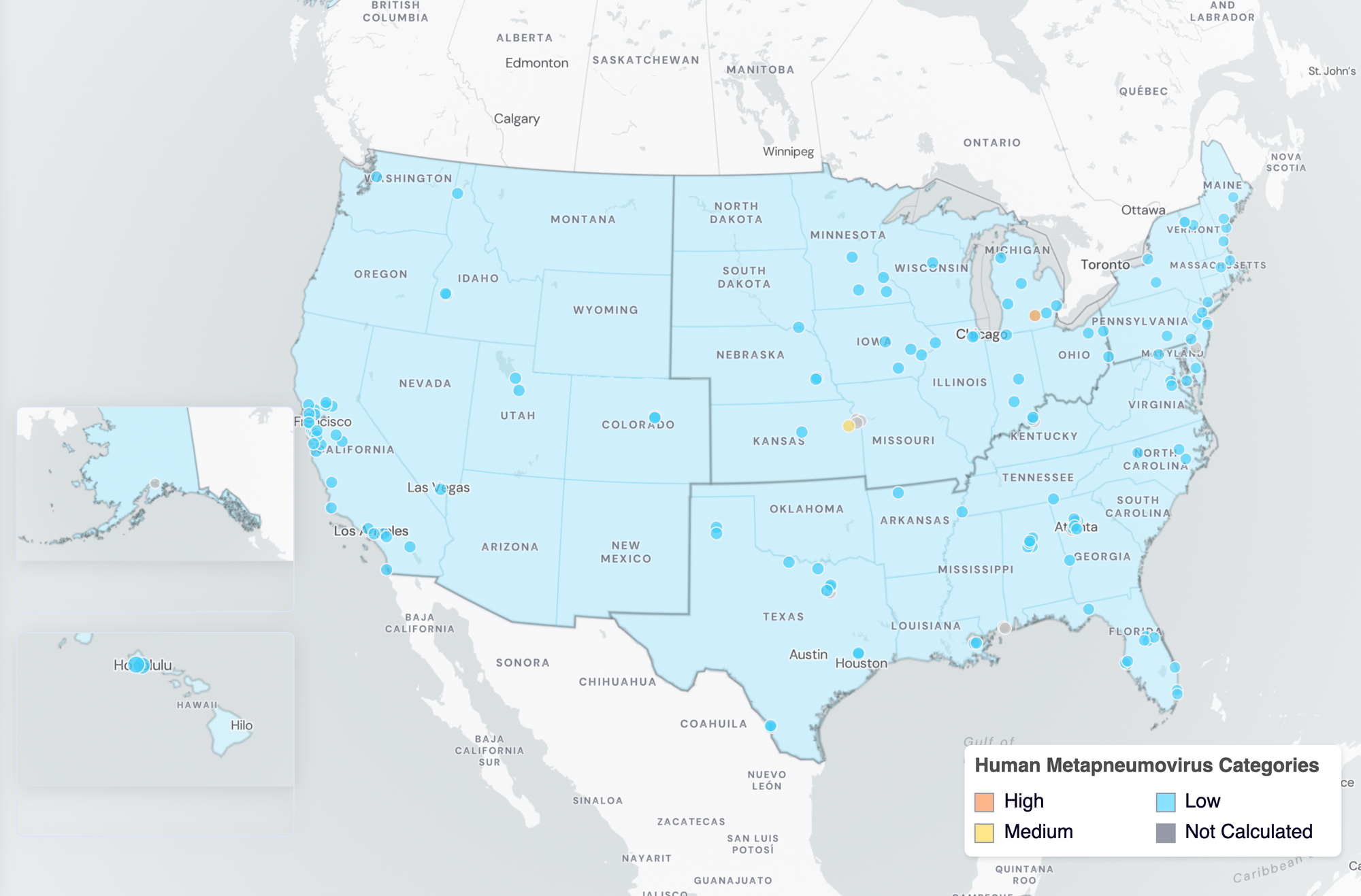
HMPV Wastewater Categories. This map includes sample collection data through July 31, 2024. Each dot represents a single site and the four US Census regions are outlined in gray. Midwest Region includes: IA, IL, IN, KS, MI, MN, NE, OH, SD, WI. Northeast Region includes: CT, MA, ME, NH, NJ, NY, PA, VT. Southern Region includes: AL, AR, DE, FL, GA, KY, LA, MD, MS, NC, TN, TX, VA, WV and Washington DC. Western Region includes: AK, CA, CO, HI, ID, NV, UT, WA.
Enterovirus D68 (EV-D68) RNA was detected in ~37% of samples collected in July 2024 across WWSCAN sites and the median concentration across all sites was below the level of detection.
The chart below plants in Florida as rows, and the days as columns (labeled at the bottom axis). White indicates no samples, blue is non-detect for EV-D68 RNA and red is detect for EV-D68 RNA.

Below are the current EV-D68 wastewater categories for all WWSCAN sites (recall the category is determined by the frequency of detection):
- 70 are in the LOW Wastewater Category
- 67 are in the MEDIUM Wastewater Category
- 0 are in the HIGH Wastewater Category
- 1 do not have enough data to calculate
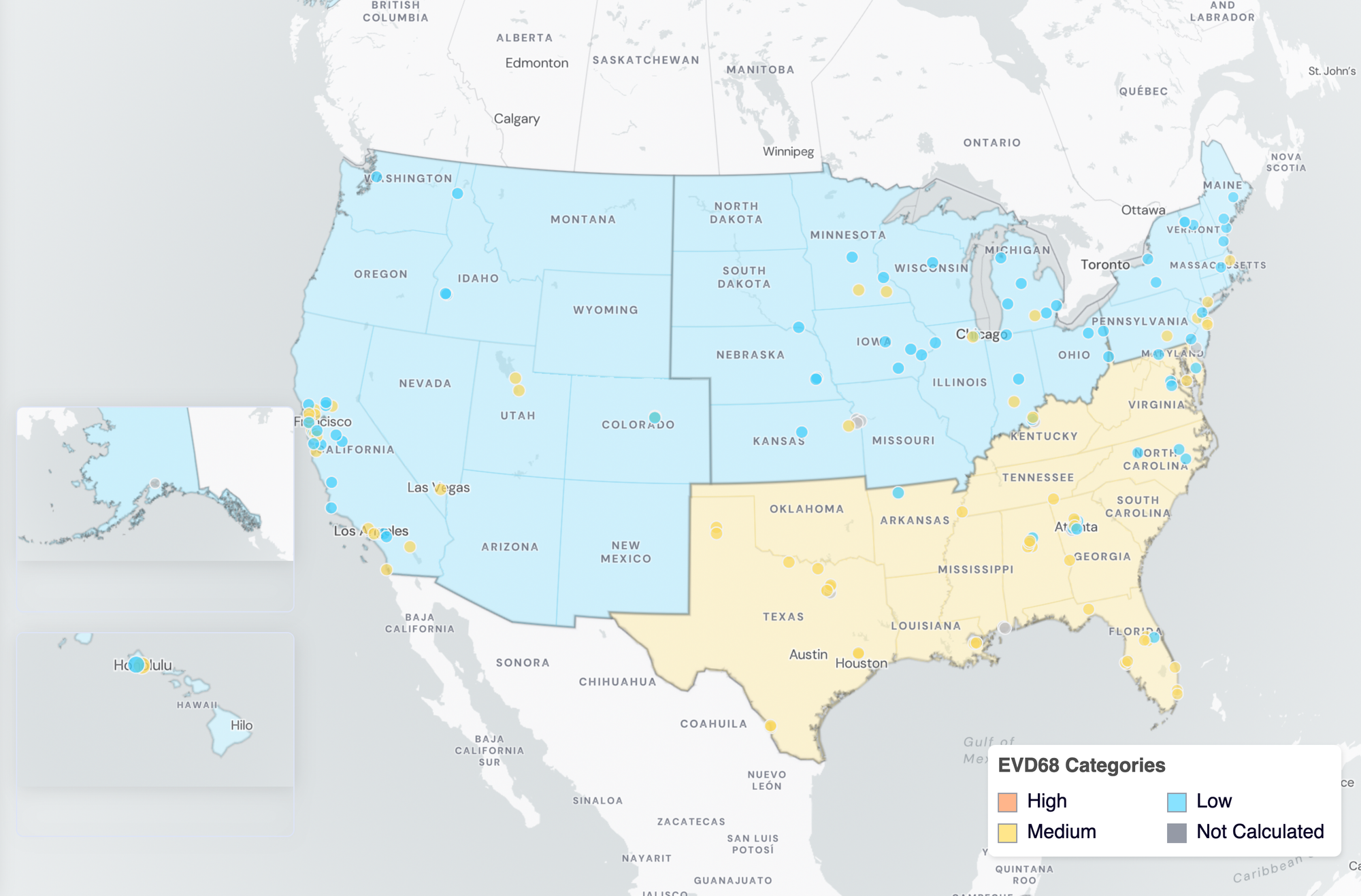
EV-D68 Wastewater Categories. This map includes sample collection data through July 31, 2024. Each dot represents a single site and the four US Census regions are outlined in gray. Midwest Region includes: IA, IL, IN, KS, MI, MN, NE, OH, SD, WI. Northeast Region includes: CT, MA, ME, NH, NJ, NY, PA, VT. Southern Region includes: AL, AR, DE, FL, GA, KY, LA, MD, MS, NC, TN, TX, VA, WV and Washington DC. Western Region includes: AK, CA, CO, HI, ID, NV, UT, WA.
Gastrointestinal Pathogens
Norovirus GII and Rotavirus
Norovirus GII (HuNoV GII) RNA was detected in all samples analyzed in June 2024. The median concentrations across all sites in July 2024 is 6,090,781 copies/gram (for reference median concentration in June 2024 was 6,038,725 copies/gram). Below are the HuNoV GII RNA concentrations (normalized by PMMoV) from all participating WWSCAN sites across the country over the last 365 days. The population-weighted average is shown.
Nationally, Norovirus is in the "Medium" Wastewater Category with aggregated measurements showing medium concentrations and a downward trend over the past 21 days.
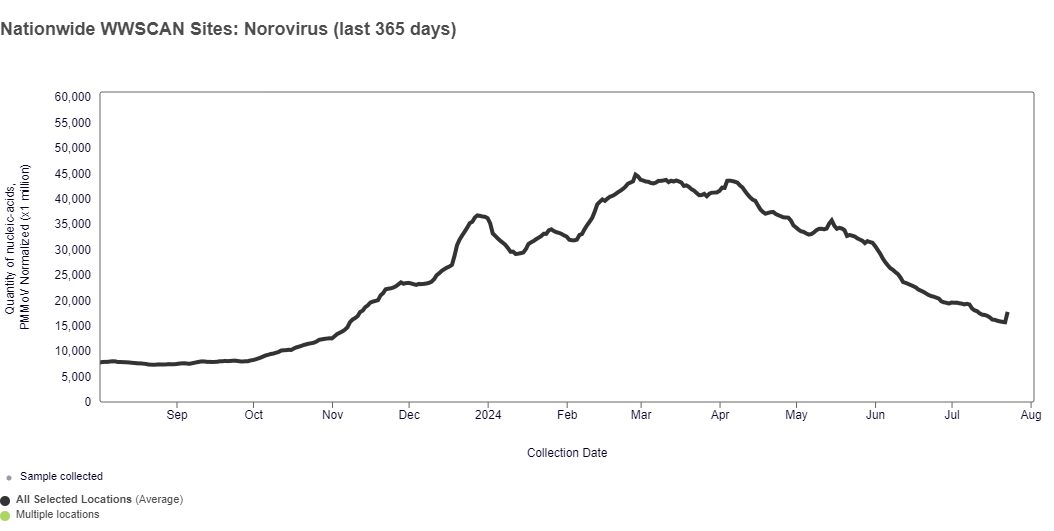
Below are the current Norovirus wastewater categories for all WWSCAN sites (recall the category is determined by both the trend and the level):
- 68 are in the LOW Wastewater Category
- 48 are in the MEDIUM Wastewater Category
- 21 are in the HIGH Wastewater Category
- 11 do not have enough data to calculate
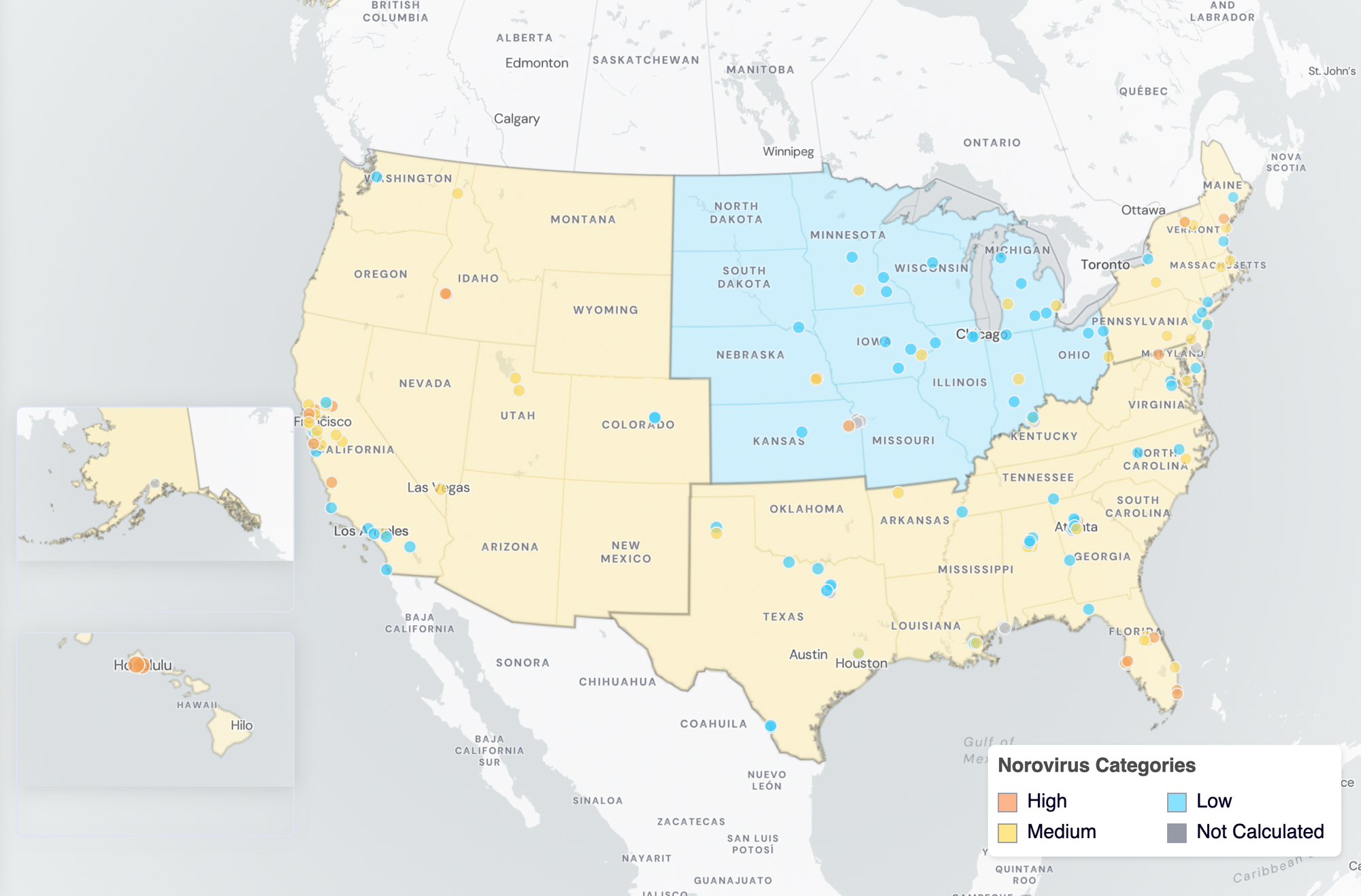
Norovirus Wastewater Categories. This map includes sample collection data through July 31, 2024. Each dot represents a single site and the four US Census regions are outlined in gray. Midwest states: IA, IL, IN, KS, MI, MN, NE, OH, SD, WI. Northeast states: CT, MA, ME, NH, NJ, NY, PA, VT. Southern states: AL, AR, DE, FL, GA, KY, LA, MD, MS, NC, TN, TX, VA, WV and Washington DC. Western States: AK, CA, CO, HI, ID, NV, UT, WA.
Rotavirus RNA median concentrations across all sites in July 2024 is 96,734 copies/gram. For reference, the median concentration in June 2024 was 104,663 copies/gram. Below are the Rotavirus RNA concentrations (normalized by PMMoV) from all participating WWSCAN sites across the country. The population-weighted average is shown.
Rotavirus is in the "Medium" Wastewater Category nationally with aggregated measurements showing medium concentrations with a downward trend in the last 21 days.
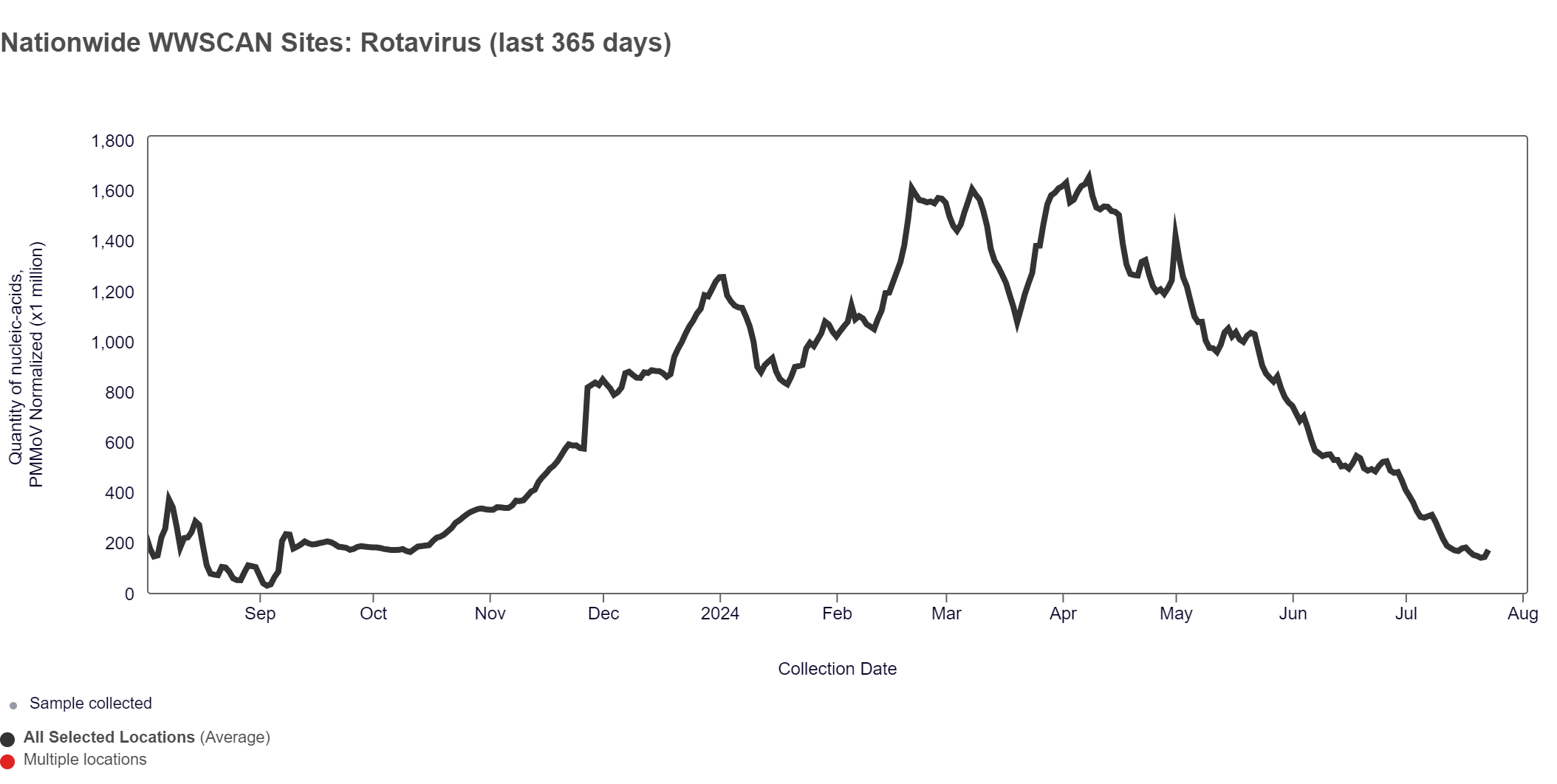
Below are the current Rotavirus wastewater categories for all WWSCAN sites (recall the category is determined by both the trend and the level):
- 110 are in the LOW Wastewater Category
- 23 are in the MEDIUM Wastewater Category
- 4 are in the HIGH Wastewater Category
- 11 do not have enough data to calculate
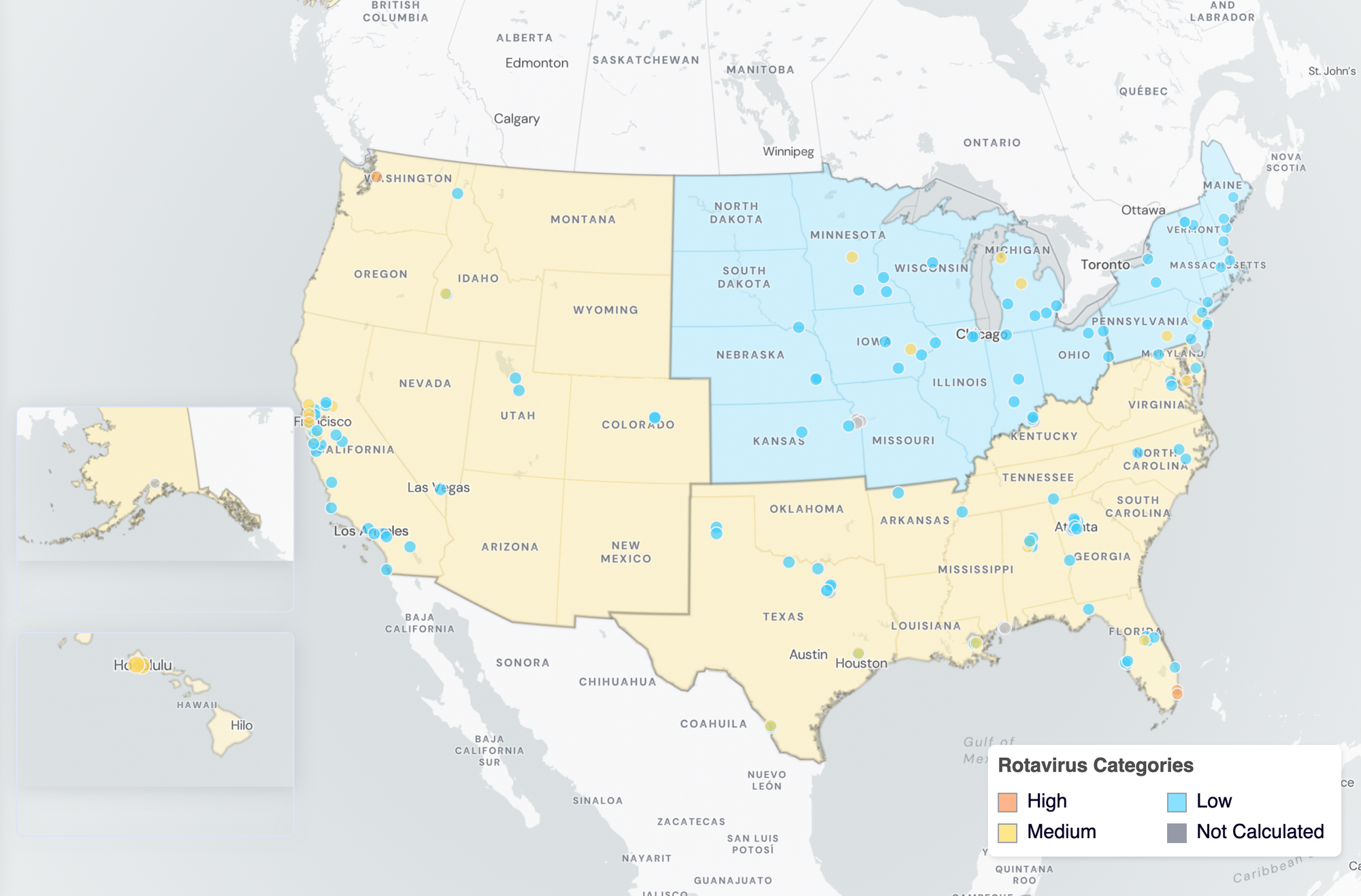
Rotavirus Wastewater Categories. This map includes sample collection data through July 31, 2024. Each dot represents a single site and the four US Census regions are outlined in gray. Midwest states: IA, IL, IN, KS, MI, MN, NE, OH, SD, WI. Northeast states: CT, MA, ME, NH, NJ, NY, PA, VT. Southern states: AL, AR, DE, FL, GA, KY, LA, MD, MS, NC, TN, TX, VA, WV and Washington DC. Western States: AK, CA, CO, HI, ID, NV, UT, WA.
Other Pathogens of Concern
Mpox, Candida auris, and Hepatitis A
Mpox DNA - We have only detected mpox DNA in 7 samples in the month of July 2024. Nationally, Mpox is in the "Low" category due to limited detections.
The chart below plants in HHS region 4 as rows, and days as columns (labeled at the bottom axis). White indicates no samples, blue is non-detect for mpox DNA and red is detect for mpox DNA.
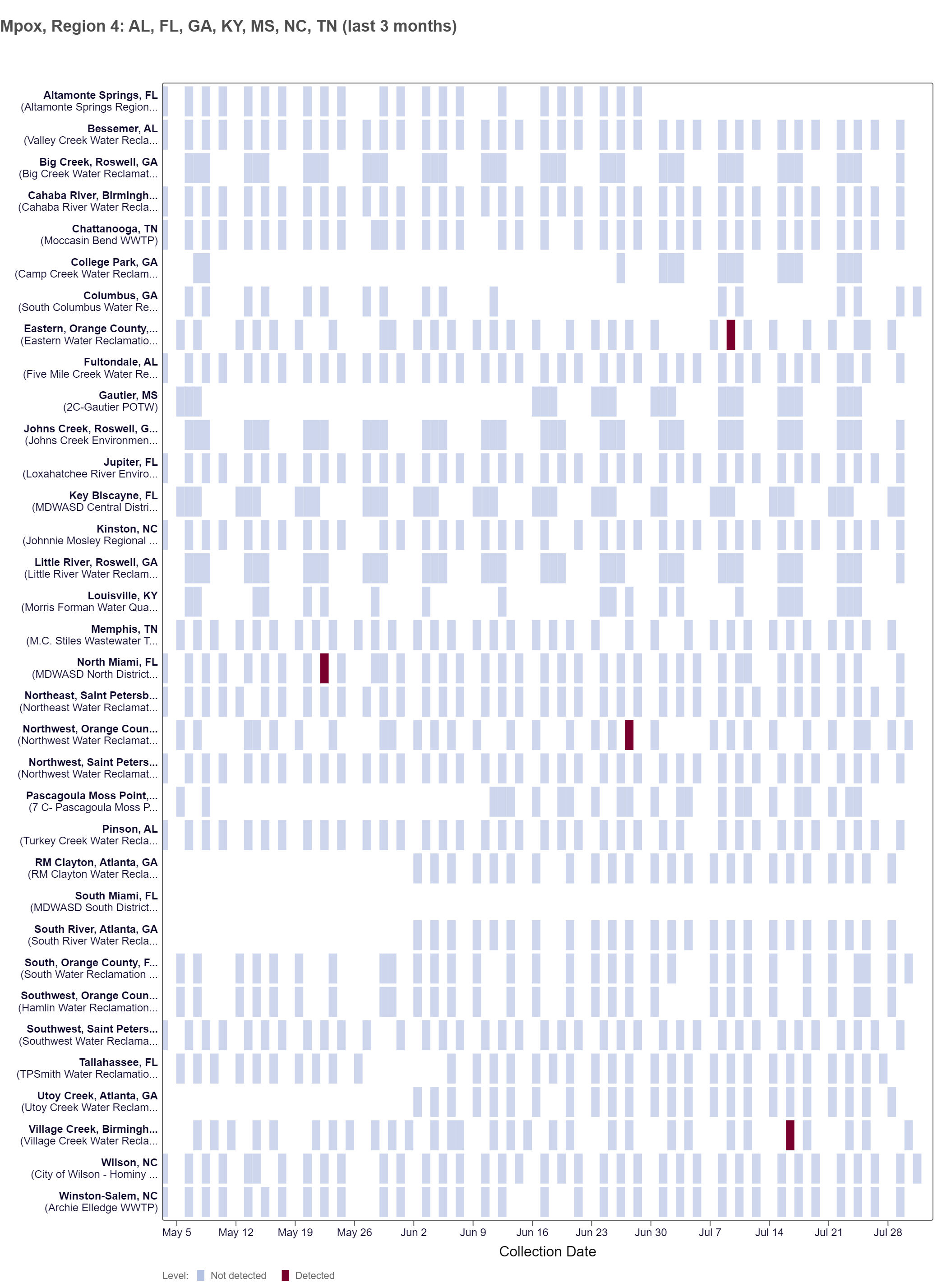
Below are the Mpox wastewater categories for all WastewaterSCAN sites (recall the category is determined by the frequency of detection):
- 137 are in the LOW Wastewater Category
- 0 are in the MEDIUM Wastewater Category
- 0 are in the HIGH Wastewater Category
- 11 do not have enough data to calculate
Candida auris (C.auris) DNA - We have detected C. auris DNA in 3.7% of samples from all WWSCAN sites in July 2024. Nationally, C. auris is in the "Low" category due to limited detections.
The chart below shows plants in HHS region 7 as rows, and days as columns (labeled at the bottom axis). White indicates no samples, blue is non-detect for C. auris DNA and red is detect for C. auris DNA.
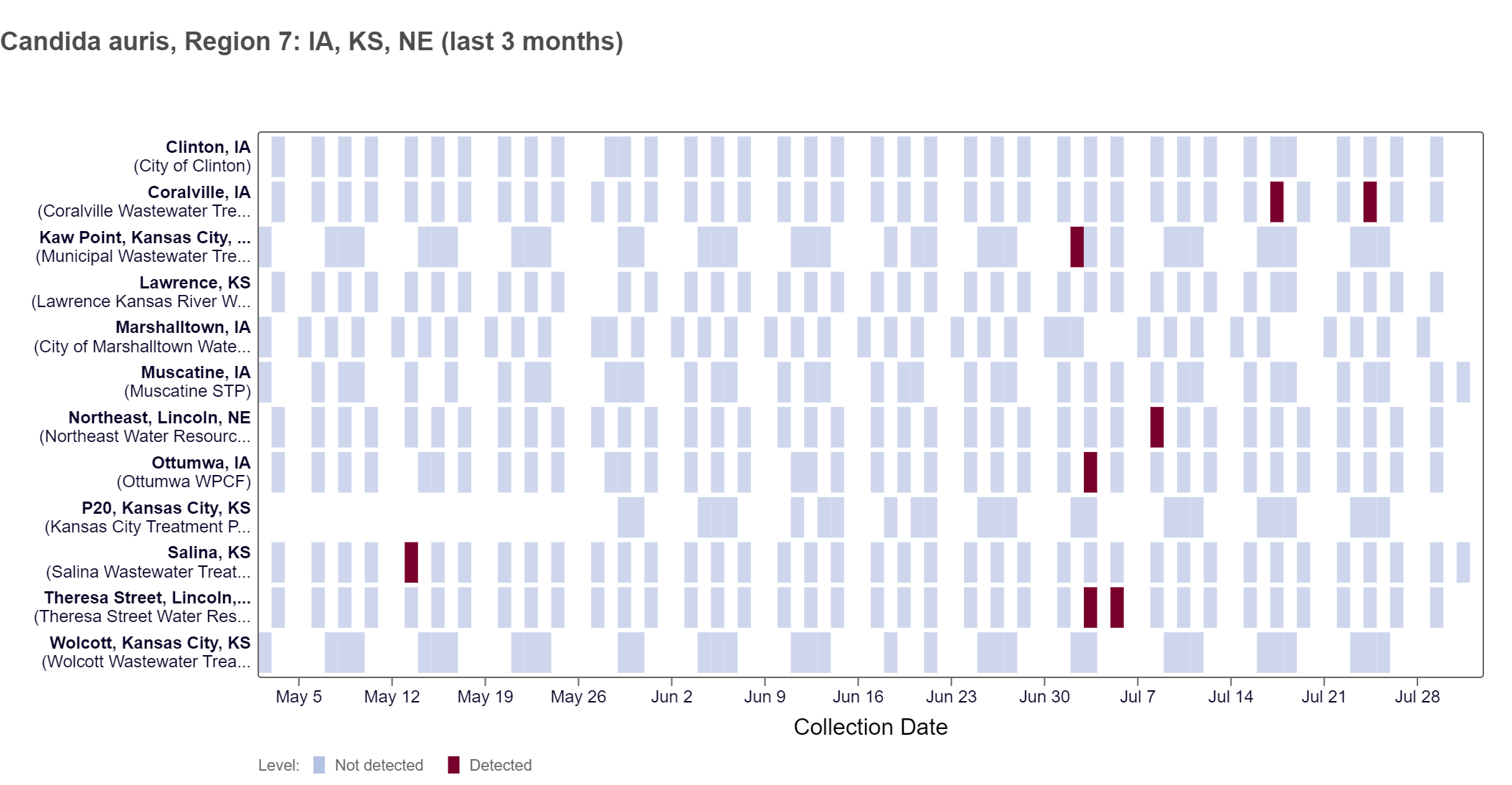
Below are the C. auris wastewater categories for all WastewaterSCAN sites (recall the category is determined by the frequency of detection):
- 131 are in the LOW Wastewater Category
- 6 are in the MEDIUM Wastewater Category
- 0 are in the HIGH Wastewater Category
- 11 do not have enough data to calculate
Hepatitis A (Hep A) RNA - We have detected Hep A RNA in 9.5% of samples from all WWSCAN sites in July 2024. Nationally, HepA is in "Low" category due to limited detections.
The chart below shows each WWSCAN plant in HHS Region 10 as rows, and days as columns (labeled at the bottom axis). White indicates no samples, blue is a non-detect for Hep A RNA and red is a detection for Hep A RNA.
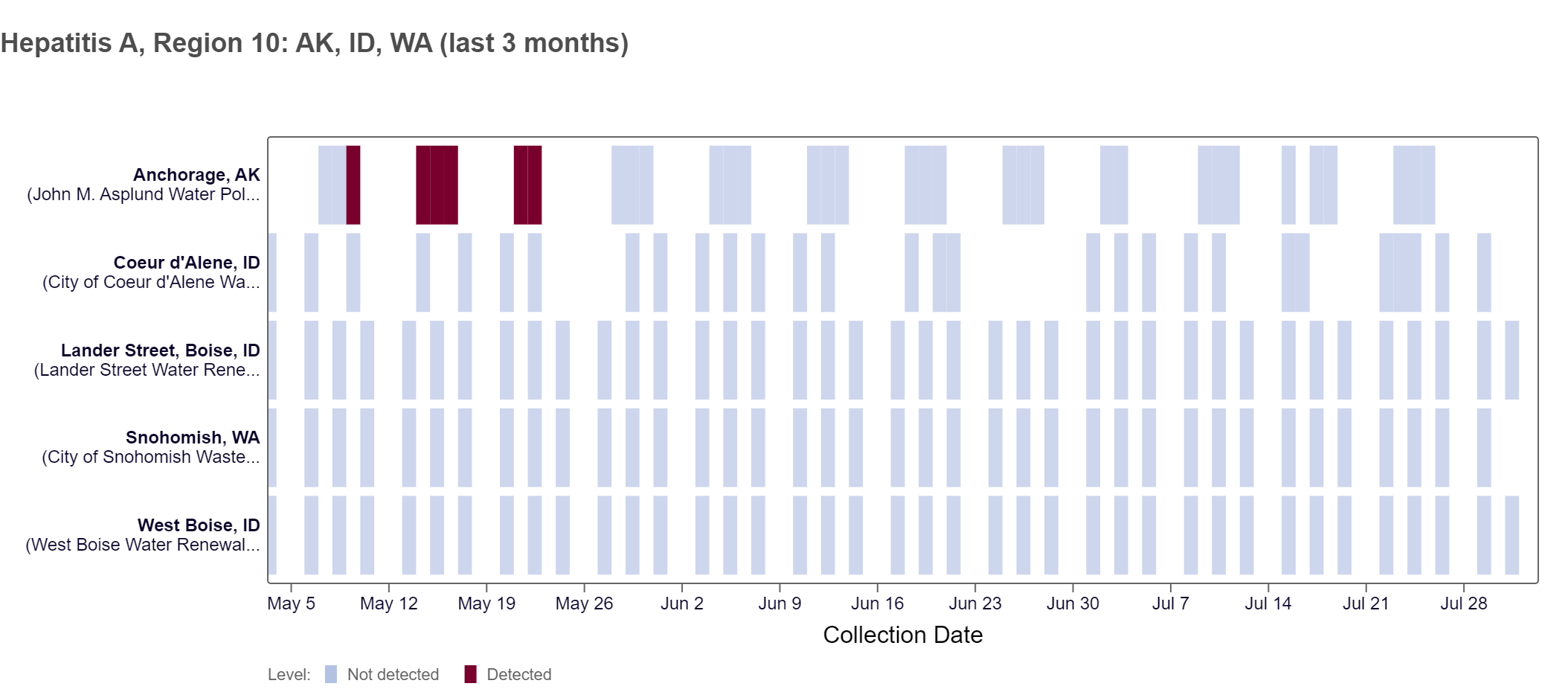
Below are the current HepA wastewater categories for all WWSCAN sites (the category is determined by the frequency of detection):
- 127 are in the LOW Wastewater Category
- 10 are in the MEDIUM Wastewater Category
- 0 are in the HIGH Wastewater Category
- 11 do not have enough data to calculate
WWSCAN protocols and methods
Protocols (Pre-analytical methods and SARS-CoV-2 analytical methods including controls):
- High Throughput RNA Extraction and PCR Inhibitor Removal of Settled Solids for Wastewater Surveillance of SARS-CoV-2 RNA
- High Throughput pre-analytical processing of wastewater settled solids for SARS-CoV-2 RNA analyses
- Quantification of SARS-CoV-2 variant mutations (HV69-70, E484K/N501Y, del156-157/R158G, del143-145, LPPA24S, S:477-505, and ORF1a Del 141-143) in settled solids using digital RT-PCR
- High Throughput SARS-COV-2, PMMoV, and BCoV quantification in settled solids using digital RT-PCR
Pre-prints and peer-reviewed publications provided WWSCAN methods:
- SARS-CoV-2
- Influenza, Human metapneumovirus, Respiratory syncytial virus, Human parainfluenza
- Mpox
- Norovirus GII
- Adenovirus group F, Rotavirus
- Candida auris
- Hepatitis A
- Enterovirus D68
Join us at the next WWSCAN Stakeholder call on August 9th, 2024
If you have questions about the website or anything else, please email: wwscan_stanford_emory@lists.stanford.edu
